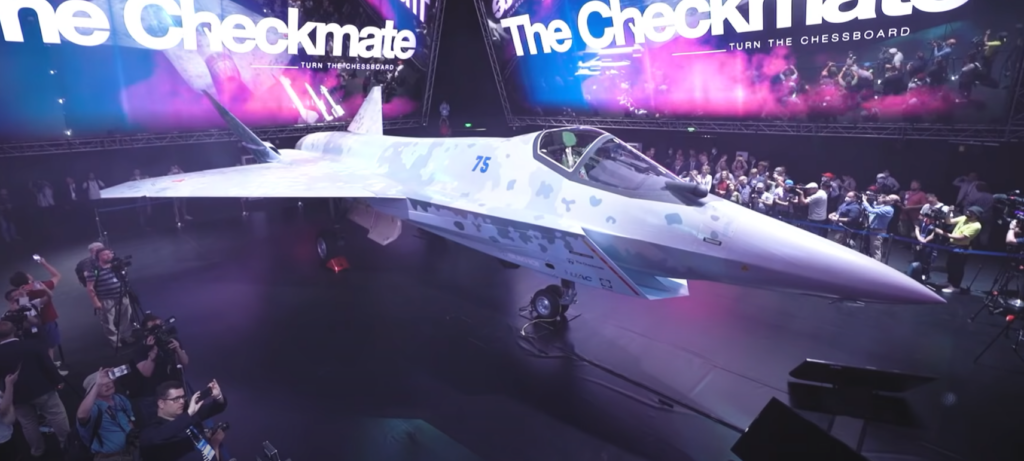
The Su-75 Checkmate is unveiled during the 2021 MAKS air show in Russia. (Youtube)
KYIV, UKRAINE: On Tuesday, Russia’s Unified Aircraft-Building Corporation (OAK) and the Sukhoi Aircraft Company used the opening day of the Moscow Aviation and Space Expo (MAKS) to take the wraps off a new single-engine stealth fighter. The roll-out of this airplane, now called the Su-75 Checkmate Light Tactical Aircraft, was made the centerpiece of the traditional Day One visit to the show by Russian President Vladimir Putin.
It’s a new design that Moscow hopes will create a niche for its combat aircraft industry in the export market. Their intent is to upend sales by competitor aircraft built by other nations — the Swedish JAS-39E/F Gripen, the Lockheed Martin F-35. and even the Shenyang J-35, a Chinese plane in development even longer than the Su-75 — by offering a cheaper, Russian-made alternative.
But there are serious questions to be answered about both the marketing strategy and the plane’s technical capabilities, which could combine to add the Su-75 to the long list of military aviation programs that never found life as an export.
In recent years, the only next-generation fighter produced in Russia has been the Sukhoi Su-57 — a twin-engine model with the overall shape of a stealthy aircraft. The other fighters still produced in Russia like the upgraded MiG-29 (called MiG-35) and the Sukhoi Su-35 are old designs dating back to the 1980s. They have little appeal in the current day when competing models are more technologically advanced and affordable.
The Su-57 has been produced thus far in small numbers (only 78 total on order) with the Russian Aerospace Forces (VKS) as the only customer — and has proven far more expensive than initially projected. It was also hamstrung when India, seen as the more promising export customer for the Su-57, declined to become an R&D or production partner; Russian fighter aircraft programs traditionally depend heavily on external customers to help launch and finance production.
Hoping to avoid that situation again, Russia proposed cooperation on the development of the Su-75 to the United Arab Emirates (UAE) in 2017. An agreement on the two nations sharing the cost of the program was to have been signed at the November 2017 Dubai Air Show. But an 11th hour announcement that Washington would reverse previous policy and allow allied Arab states to acquire the F-35 scuttled the deal.
Still, a promotional video released just a few days ago reveals that Russia has not given up on a sale to the oil-rich and financial powerhouse Gulf state. The film opens with a pilot in the UAE packing up his flight kit after receiving a scramble alert on his smartphone.
This scene is followed by pilots in three countries looked upon by the Russians as the most near-term customers — India, Vietnam and Argentina — receiving a similar return-to-base signal. They all join up in a group with pilots of a dozen other nations at an aerodrome as the aircraft is rolled out of a hangar. The message: Su-75 can be another multinational program — just like the F-35.
The aircraft is not going to be available any time soon, however. First flight of the new prototype is at least two years away. A series-manufactured version at least five to seven years in the future. And nations that are seen as the best prospects for a foreign sale may not be in a situation to wait that long.
Design and Performance Details
Discussions with Russian industry sources, plus a July 20th evening presentation by OAK General Director Yuri Slyusar and Su-75 Chief Designer Aleksei Bulatov have provided details about the program.
- The project has moved beyond the paper design and mock-up stage, with the aircraft shown this week being an actual prototype demonstrator. Its design utilizes lessons learned from the Su-57 and is powered by one of the larger aircraft’s two 5th-generation izdeliye 30 engines.
- The Russian design team has employed a full-complement of high-end digital resources, with the planform of the aircraft developed using supercomputer-based Computational Fluid Dynamics and Radar Cross Section (RCS) configuration tools.
- The operation of the aircraft is supported by an automated logistics system called “Matryoska” — a reference to the famous nested, wooden hand-made dolls — to symbolize the ease and modular makeup of the aircraft. The electronic infrastructure of the airplane is all open-architecture and makes use of diagnostics systems that are mostly on-board. This minimizes the quantity of equipment needed on an aerodrome to maintain the aircraft. (Such a system echoes the F-35 ALIS system, which has been a major source of headaches for operators of the Lockheed Martin produced jet.)
- Like other stealthy designs, the Su-75 carries missiles in an internal weapons bay. Information plaques displayed with the prototype state it carries the same air-launched munitions employed by both the Su-35 and Su-57. Maximum weapons load is stated as 16,300 lbs.
- The single engine produces 24,000 lbs of dry thrust and 39,000 lbs in afterburner. This should produce a thrust-to-weight ratio of better than 1.00, but questions remain about the empty weight of the aircraft. The range of the aircraft on internal fuel with no external tanks is 1,800 miles.
The design team also claims that there is a high wing lift efficiency associated with the design. Particular attention has been given to the “V”-shaped vertical tail which accounts for part of the aircraft’s low RCS.
Overall, while the aircraft is being presented as a new development, it is reportedly based on a lightweight fighter concept originally developed at Mikoyan Design Bureau more than 7 years ago. One long-time Russian aircraft industry specialist in Moscow told Breaking Defense, “it is somewhat of a surprise that this design is now being credited to Sukhoi as most of the serious work on this kind of a single-engine platform was performed at MiG long ago.”
Program Priorities
The two officials making the presentation stated that one of the chief priorities for the Su-75 was “today there is no single-engine, fifth generation fighter available at a reasonable price. The customers we have been talking to want a non-expensive aircraft and one in which they can shape their own requirements.”
The unit cost that has been associated with the aircraft is US $25-30 million, which is the price point that the design team thinks will interest their primary target customers. This focus on export sales is essential to the program’s success as the VKS are presently not interested in any single-engine design.

A screengrab from a Sukhoi promotional video makes prominent the nations the Russian firm hopes will buy the new Su-75. (Youtube)
Slyusar stated that the hope of OAK and Sukhoi is that they will be able to “romance” the VKS in ordering the Su-75, but to date the program is financed with company funds and there is no government support at present. In the meantime, there “are conversations on-going with different potential [export] buyers” and that one of the additional modifications of the fighter being discussed is “a carrier version.”
Sources in Moscow point out that the VKS desperately needs affordable fighters that can be built in large numbers, but the force’s leadership may not support Su-75’s production. It would also be problematic to sell this aircraft to export customers without it being a program of record in Russia. Also, if there are no more than a handful of export sales, the numbers do not reach required economies of scale to support a production run.
A carrier variant of the Su-75 would almost certainly be proposed for the Indian Navy as a replacement for the MiG-29K carrier-capable fighter the force currently operates. The design team has also been evaluating the possibility of a two-seat variant, as well as an unmanned version, but there are no prospective buyers that have expressed interest in either of these options.
The big question mark is whether Moscow’s industry can carry through with this design concept to turn out a fully functional aircraft. The defense industrial base has suffered considerable contractions in its capacity and overall size since 2017. Critical personnel have also died in the last year due to the COVID pandemic, to include the general designer of the NIIP radar design bureau, Yuri Beliy.
While the Sukhoi designers have proven they can turn out an actual prototype of this new aircraft, the non-ferrous/composite materials used in its construction may still be a question mark. In his presentation, Slyusar stated that it would take at least a year to complete the static “shake and bake” tests of the aircraft’s structure. This will be a real test of Russia’s composite materials industry, which is not nearly as well-developed as it is in the US or Europe.
Those materials are key to the aircraft’s low RCS. Not only would they have to be produced to extreme tolerances and the sections joined together without so much as a micron between them, but they would also have to have their radar-absorbing properties “baked-in” at the kiln for the aircraft to be a low-maintenance platform as advertised. But Russia’s approach to stealth in the past has been the opposite — a heavy reliance on coatings and appliques that are labor-intensive and require top-to-bottom refurbishing after every flight.
The other factor is that what makes a modern fighter aircraft effective in combat are its on-board systems, which in the past have been the proverbial “long pole in the tent” of Russian fighter designs. The izdeliye 30 engine is not in series-production yet and is still completing flight tests. Also, according to industry sources, Russia still has not been able to design a cost-effective AESA radar set and has problems with the technology required to manufacture the radar’s transit/receive modules.
Both the OAK and Sukhoi officials state that the airplane should make a first flight in two years and that series production could begin in as soon as four, although most experienced observers state that 5-7 years is a more realistic. Program projections such as these have a tendency to always move to the right — even in countries with more than one generation of experience in designing stealth aircraft.
Therefore, it is not unreasonable to suggest that the full-scale production of the Su-75 could be a much longer time in coming — if ever.